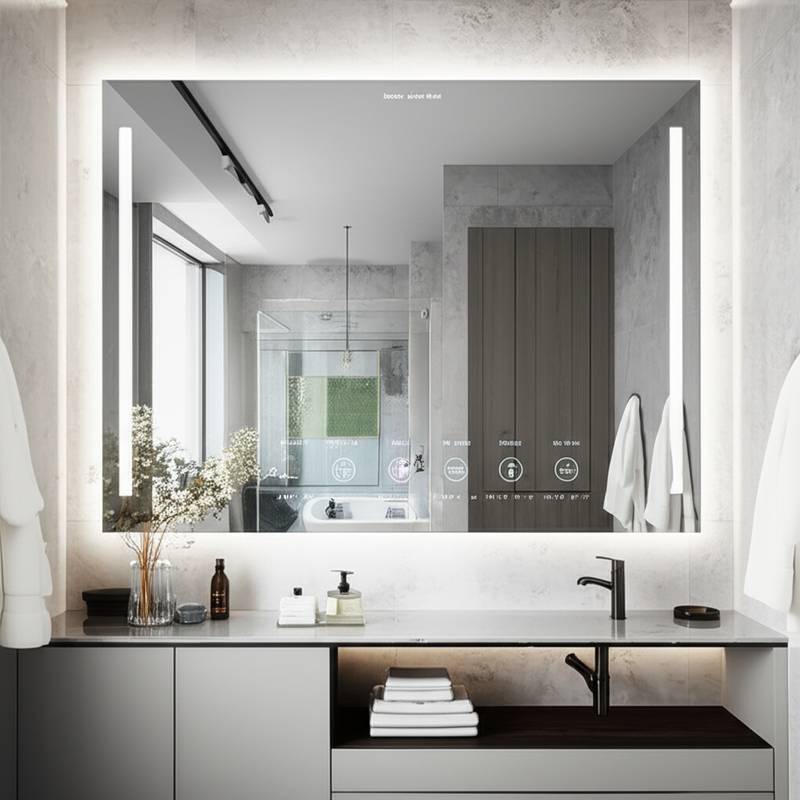Smart Mirrors Monitor Vitals During Morning Routines
Picture this scenario: you begin your day by brushing your teeth, and your mirror silently assesses your heart rate, hydration status, and stress indicators. This capability represents current advancements in connected home systems rather than a remote future prospect. Smart mirrors emerge as pivotal elements in residential spaces, integrating health monitoring with routine tasks. Bathrooms gradually function as dedicated wellness areas, where these devices render health checks as simple as a daily wash.
Evolving from Basic Reflection to Data-Driven Interaction
Conventional mirrors merely display visual reflections. Smart mirrors incorporate sensors, cameras, and network features to provide data alongside imagery. They fuse the standard mirror design with health monitoring functions, delivering bodily condition details each time you approach. Devices often employ optical sensors akin to those in wearable fitness trackers. These detect minor variations in skin color linked to pulse and oxygen saturation, or interpret facial expressions to gauge stress and exhaustion levels.
For users, this development enables passive health monitoring within established daily practices. No need for wearable bands, timepieces, or manual entries. A brief look and teeth cleaning suffice while vital metrics collect automatically.
Interactive Health Displays Mounted on Walls
Recent smart mirror iterations surpass mere imagery to serve as dynamic health interfaces. Certain models project resting heart rate, core temperature, and hydration metrics onto the surface. Additional variants connect with smartphones or smartwatches to compile comprehensive wellness records. Such synchronization yields a cohesive health overview across gadgets, aiding in the identification of overlooked trends.
Initial users characterize these mirrors as reliable wellness partners beyond typical fixtures. They introduce clinical-grade biometric information into domestic settings. A momentary view discloses sleep quality, elevated stress, or insufficient hydration. Gradually, the device adapts to individual baselines, supplying tailored advice and subtle prompts to drink fluids, relax, or engage in activity.
Core Technologies Powering the System
Beneath the polished exterior, smart mirrors integrate sensors, imaging devices, and computational algorithms. Optical components track skin hue shifts tied to circulation, facilitating pulse estimation. Infrared elements measure thermal output. Select models feature audio capture and movement sensors to observe sleep cycles or respiratory patterns. Data undergoes local or secure cloud analysis prior to presentation in straightforward graphics.
Designers emphasize data security. Health records receive encryption, with options for users to select sharing or retention preferences. Certain units support entirely on-site storage, empowering residents with data management authority. This commitment to clarity fosters user trust amid the rise of health-focused smart appliances.
Integrating Health into Daily Practices
Smart mirrors excel by converting routine actions into wellness opportunities. Individuals typically commence and conclude days before a mirror, positioning it perfectly for health oversight. Rather than introducing extra devices, the mirror enhances existing behaviors into systematic evaluations.
Prompt identification stands as a primary benefit. Incremental shifts in pulse, heat, or complexion may indicate weariness, tension, or fluid deficit prior to symptom awareness. In homes with elderly relatives, these mirrors offer reassurance through trend surveillance that signals potential concerns. Information sharing with attendants or physicians proves feasible, supporting early intervention and proactive health strategies.
Practical Implementations in Use
Multiple companies deliver these innovations to residences. Full-height variants suit bedrooms or exercise zones, providing exercise metrics and alignment guidance. Compact designs mount over lavatory basins, merging monitoring with adjustable illumination and verbal commands. One configuration utilizes built-in imaging to evaluate dermal health, delivering customized care suggestions derived from moisture and coloration.
Another variant pairs with digital weighing devices to chart physical makeup changes longitudinally. These offerings illustrate the transition of smart mirrors from upscale accommodations to everyday dwellings. Costs decline with expanded manufacturing, and contemporary constructions incorporate compatible bathroom setups.
Fitting into Broader Wellness Networks
Smart mirrors integrate within expansive home wellness frameworks. Connected to intelligent lighting, they modulate intensity and hue according to emotional state or rest phases. Allied with digital aides, they access calendars, issue fluid intake alerts, or broadcast soothing audio during evening preparations. Certain setups link to activity applications, displaying performance data alongside motivational displays.
This connectivity signifies a move from personal wearables to ambient awareness. Environments evolve into monitoring networks. Residences gain insight into habits and respond accordingly, subtly promoting enhanced vitality and comfort.
Addressing Limitations and Key Factors
Despite the appeal, operational constraints persist. Precision relies on steady illumination and placement, with sensor efficacy varying by complexion or state. Premium units carry elevated prices, although reductions anticipate broader uptake. Data protection continues as a critical issue, demanding ethical management to sustain confidence.
Producers counter with enhanced user oversight and open policies. Offline operations or in-home processing options now prevail, keeping details within the premises. These measures ease adoption of such personal tech in sensitive areas like restrooms and sleeping quarters.
Shaping Tomorrow's Domestic Spaces
Bathrooms advance as among the most intelligent household zones. Formerly limited to personal care, they develop into individualized health environments. Smart mirrors advance this direction, merging everyday tasks with monitoring seamlessly. Health intelligence integrates into natural flows, eliminating added efforts.
Embracing Health Insights in Reflections
Consider a mirror that scrutinizes wellness alongside appearance; such integration materializes soon. Smart mirrors approach ubiquity, comparable to climate controls or digital helpers. They portray not only exteriors but internal states, furnishing routine vitality assessments. The elegance resides in unobtrusive design, requiring no habit alterations or intricate operations.
